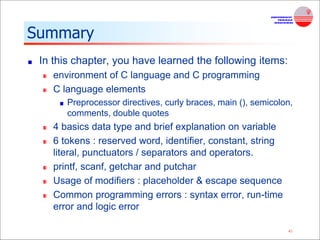Fundamental of C Programming Language and Basic Input/Output Function
- 1. 1 Chapter 3 Fundamental of C Programming Language and Basic Input/Output Function
- 2. 2 Chapter 3: Fundamental of C and Input/Output In this chapter you will learn about: C Development Environment C Program Structure Basic Data Types Input/Output function Common Programming Error
- 3. 3 C Development Environment DiskPhase 2 : Preprocessor program processes the code. DiskCompilerPhase 3 : Compiler creates object code and stores it on Disk. Preprocessor DiskLinkerPhase 4 : EditorPhase 1 : Program is created using the Editor and stored on Disk. Disk Linker links object code with libraries, creates a.out and stores it on Disk
- 4. 4 C Development Environment cont LoaderPhase 5 : : . Primary Memory Loader puts Program in Memory C P U (execute)Phase 6 : : . Primary Memory CPU takes each instruction and executes it, storing new data values as the program executes.
- 5. 5 Entering, translating, and running a High-Level Language Program
- 6. 6 C Program Structure An example of simple program in C #include <stdio.h> void main(void) { printf(“I love programmingn”); printf(“You will love it too once ”); printf(“you know the trickn”); }
- 7. 7 Preprocessor directives a C program line begins with # provides an instruction to the C preprocessor It is executed before the actual compilation is done. Two most common directives : #include #define In our example (#include<stdio.h>) identifies the header file for standard input and output needed by the printf().
- 8. 8 Function main Identify the start of the program Every C program has a main ( ) 'main' is a C keyword. We must not use it for any other variable. 4 common ways of main declaration int main(void) { return 0; } void main(void) { } main(void) { } main( ) { }
- 9. 9 The curly braces { } Identify a segment / body of a program The start and end of a function The start and end of the selection or repetition block. Since the opening brace indicates the start of a segment with the closing brace indicating the end of a segment, there must be just as many opening braces as closing braces (this is a common mistake of beginners)
- 10. 10 Statement A specification of an action to be taken by the computer as the program executes. Each statement in C needs to be terminated with semicolon (;) Example: #include <stdio.h> void main(void) { printf(“I love programmingn”); printf(“You will love it too once ”); printf(“you know the trickn”); } statement statement statement
- 11. 11 Statement cont… Statement has two parts : Declaration The part of the program that tells the compiler the names of memory cells in a program Executable statements Program lines that are converted to machine language instructions and executed by the computer
- 12. 12 C program skeleton In short, the basic skeleton of a C program looks like this: #include <stdio.h> void main(void) { statement(s); } Preprocessor directives Function main Start of segment End of segment
- 13. 13 Identifiers Words used to represent certain program entities (variables, function names, etc). Example: int my_name; my_name is an identifier used as a program variable void CalculateTotal(int value) CalculateTotal is an identifier used as a function name
- 14. 14 Rules for naming identifiers Rules Example Can contain a mix of characters and numbers. However it cannot start with a number H2o First character must be a letter or underscore Number1; _area Can be of mixed cases including underscore character XsquAre my_num Cannot contain any arithmetic operators R*S+T … or any other punctuation marks… #@x%!! Cannot be a C keyword/reserved word struct; printf; Cannot contain a space My height … identifiers are case sensitive Tax != tax
- 15. 15 Variables Variable a name associated with a memory cell whose value can change Variable Declaration: specifies the type of a variable Example: int num; Variable Definition: assigning a value to the declared variable Example: num = 5;
- 16. 16 Basic Data Types There are 4 basic data types : int float double char int used to declare numeric program variables of integer type whole numbers, positive and negative keyword: int int number; number = 12;
- 17. 17 Basic Data Types cont… float fractional parts, positive and negative keyword: float float height; height = 1.72; double used to declare floating point variable of higher precision or higher range of numbers exponential numbers, positive and negative keyword: double double valuebig; valuebig = 12E-3;
- 18. 18 Basic Data Types cont… char equivalent to ‘letters’ in English language Example of characters: Numeric digits: 0 - 9 Lowercase/uppercase letters: a - z and A - Z Space (blank) Special characters: , . ; ? “ / ( ) [ ] { } * & % ^ < > etc single character keyword: char char my_letter; my_letter = 'U'; In addition, there are void, short, long, etc. The declared character must be enclosed within a single quote!
- 19. 19 Constants Entities that appear in the program code as fixed values. Any attempt to modify a CONSTANT will result in error. 4 types of constants: Integer constants Positive or negative whole numbers with no fractional part Example: – const int MAX_NUM = 10; – const int MIN_NUM = -90; Floating-point constants (float or double) Positive or negative decimal numbers with an integer part, a decimal point and a fractional part Example: – const double VAL = 0.5877e2; (stands for 0.5877 x 102)
- 20. 20 Constants cont… Character constants A character enclosed in a single quotation mark Example: – const char letter = ‘n’; – const char number = ‘1’; – printf(“%c”, ‘S’); » Output would be: S Enumeration Values are given as a list Example: enum Language { Malay, English, Arabic };
- 21. 21 Constant example – volume of a cone #include <stdio.h> void main(void) { const double pi = 3.412; double height, radius, base, volume; printf(“Enter the height and radius of the cone:”); scanf(“%lf %lf”,&height, &radius); base = pi * radius * radius; volume = (1.0/3.0) * base * height; printf(“nThe volume of a cone is %f ”, volume); }
- 22. 22 #define You may also associate constant using #define preprocessor directive #include <stdio.h> #define pi 3.412 void main(void) { double height, radius, base, volume; printf(“Enter the height and radius of the cone:”); scanf(“%lf %lf”,&height,&radius); base = pi * radius * radius; volume = (1.0/3.0) * base * height; printf(“nThe volume of a cone is %f ”, volume); }
- 23. 23 Input/Output Operations Input operation an instruction that copies data from an input device into memory Output operation an instruction that displays information stored in memory to the output devices (such as the monitor screen)
- 24. 24 Input/Output Functions A C function that performs an input or output operation A few functions that are pre-defined in the header file stdio.h such as : printf() scanf() getchar() & putchar()
- 25. 25 The printf function Used to send data to the standard output (usually the monitor) to be printed according to specific format. General format: printf(“string literal”); A sequence of any number of characters surrounded by double quotation marks. printf(“format string”, variables); Format string is a combination of text, conversion specifier and escape sequence.
- 26. 26 The printf function cont… Example: printf(“Thank you”); printf (“Total sum is: %dn”, sum); %d is a placeholder (conversion specifier) – marks the display position for a type integer variable n is an escape sequence – moves the cursor to the new line
- 27. 27 Escape Sequence Escape Sequence Effect a Beep sound b Backspace f Formfeed (for printing) n New line r Carriage return t Tab v Vertical tab Backslash ” “ sign o Octal decimal x Hexadecimal O NULL
- 28. 28 Placeholder / Conversion Specifier No Conversion Specifier Output Type Output Example 1 %d Signed decimal integer 76 2 %i Signed decimal integer 76 3 %o Unsigned octal integer 134 4 %u Unsigned decimal integer 76 5 %x Unsigned hexadecimal (small letter) 9c 6 %X Unsigned hexadecimal (capital letter) 9C 7 %f Integer including decimal point 76.0000 8 %e Signed floating point (using e notation) 7.6000e+01 9 %E Signed floating point (using E notation) 7.6000E+01 10 %g The shorter between %f and %e 76 11 %G The shorter between %f and %E 76 12 %c Character ‘7’ 13 %s String ‘76'
- 29. 29 The scanf function Read data from the standard input device (usually keyboard) and store it in a variable. General format: scanf(“Format string”, &variable); Notice ampersand (&) operator : C address of operator it passes the address of the variable instead of the variable itself tells the scanf() where to find the variable to store the new value
- 30. 30 The scanf function cont… Example : int age; printf(“Enter your age: “); scanf(“%d”, &age); Common Conversion Identifier used in printf and scanf functions. printf scanf int %d %d float %f %f double %f %lf char %c %c string %s %s
- 31. 31 The scanf function cont… If you want the user to enter more than one value, you serialise the inputs. Example: float height, weight; printf(“Please enter your height and weight:”); scanf(“%f%f”, &height, &weight);
- 32. 32 getchar() and putchar() getchar() - read a character from standard input putchar() - write a character to standard output Example: #include <stdio.h> void main(void) { char my_char; printf(“Please type a character: ”); my_char = getchar(); printf(“nYou have typed this character: ”); putchar(my_char); }
- 33. 33 getchar() and putchar() cont Alternatively, you can write the previous code using normal scanf and %c placeholder. Example #include <stdio.h> void main(void) { char my_char; printf(“Please type a character: ”); scanf(“%c”,&my_char); printf(“nYou have typed this character: %c ”, my_char); }
- 34. 34 Few notes on C program… C is case-sensitive Word, word, WorD, WORD, WOrD, worD, etc are all different variables / expressions Eg. sum = 23 + 7 What is the value of Sum after this addition ? Comments (remember 'Documentation'; Chapter 2) are inserted into the code using /* to start and */ to end a comment Some compiler support comments starting with ‘//’ Provides supplementary information but is ignored by the preprocessor and compiler /* This is a comment */ // This program was written by Hanly Koffman
- 35. 35 Few notes on C program cont… Reserved Words Keywords that identify language entities such as statements, data types, language attributes, etc. Have special meaning to the compiler, cannot be used as identifiers (variable, function name) in our program. Should be typed in lowercase. Example: const, double, int, main, void,printf, while, for, else (etc..)
- 36. 36 Few notes on C program cont… Punctuators (separators) Symbols used to separate different parts of the C program. These punctuators include: [ ] ( ) { } , ; “: * # Usage example: void main (void) { int num = 10; printf (“% d”,num); }
- 37. 37 Few notes on C program cont… Operators Tokens that result in some kind of computation or action when applied to variables or other elements in an expression. Example of operators: * + = - / Usage example: result = total1 + total2;
- 38. 38 Common Programming Errors Debugging Process removing errors from a program Three (3) kinds of errors : Syntax Error a violation of the C grammar rules, detected during program translation (compilation). statement cannot be translated and program cannot be executed
- 39. 39 Common Programming Errors cont… Run-time errors An attempt to perform an invalid operation, detected during program execution. Occurs when the program directs the computer to perform an illegal operation, such as dividing a number by zero. The computer will stop executing the program, and displays a diagnostic message indicates the line where the error was detected
- 40. 40 Common Programming Errors cont… Logic Error/Design Error An error caused by following an incorrect algorithm Very difficult to detect - it does not cause run- time error and does not display message errors. The only sign of logic error – incorrect program output Can be detected by testing the program thoroughly, comparing its output to calculated results To prevent – carefully desk checking the algorithm and written program before you actually type it
- 41. 41 Summary In this chapter, you have learned the following items: environment of C language and C programming C language elements Preprocessor directives, curly braces, main (), semicolon, comments, double quotes 4 basics data type and brief explanation on variable 6 tokens : reserved word, identifier, constant, string literal, punctuators / separators and operators. printf, scanf, getchar and putchar Usage of modifiers : placeholder & escape sequence Common programming errors : syntax error, run-time error and logic error










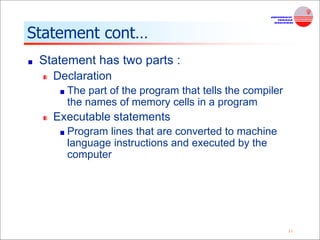
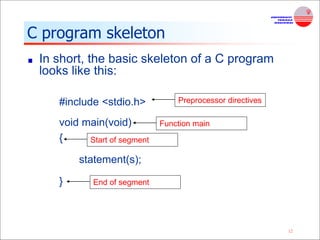



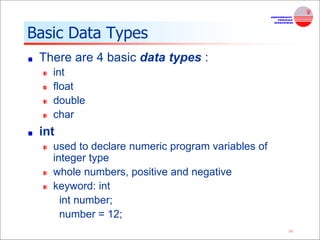

![18
Basic Data Types cont…
char
equivalent to ‘letters’ in English language
Example of characters:
Numeric digits: 0 - 9
Lowercase/uppercase letters: a - z and A - Z
Space (blank)
Special characters: , . ; ? “ / ( ) [ ] { } * & % ^ < > etc
single character
keyword: char
char my_letter;
my_letter = 'U';
In addition, there are void, short, long, etc.
The declared character must be
enclosed within a single quote!](https://image.slidesharecdn.com/chapter3fundamentalinputoutput-191003183019/85/Fundamental-of-C-Programming-Language-and-Basic-Input-Output-Function-18-320.jpg)
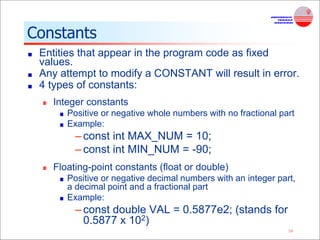

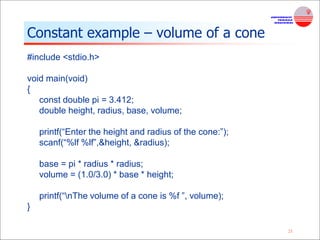


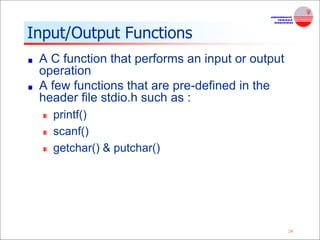




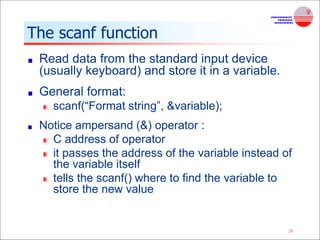






![36
Few notes on C program cont…
Punctuators (separators)
Symbols used to separate different parts of
the C program.
These punctuators include:
[ ] ( ) { } , ; “: * #
Usage example:
void main (void)
{
int num = 10;
printf (“% d”,num);
}](https://image.slidesharecdn.com/chapter3fundamentalinputoutput-191003183019/85/Fundamental-of-C-Programming-Language-and-Basic-Input-Output-Function-36-320.jpg)




